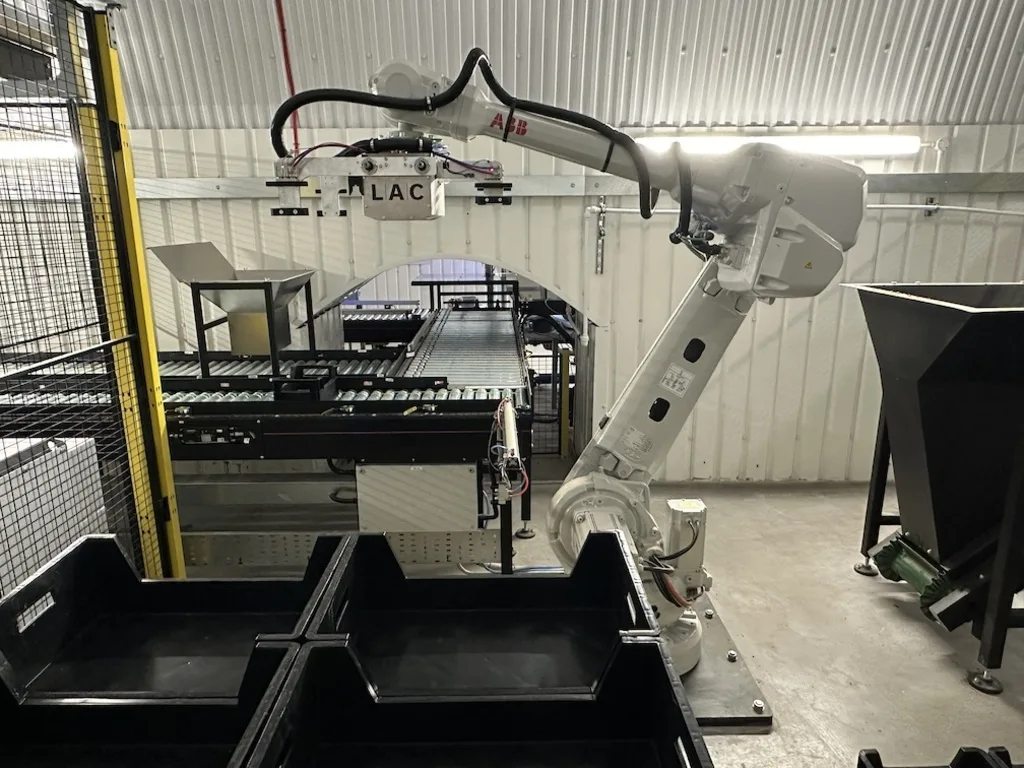Automated solution for insect farm
LAC Logistics Automation has designed and installed a bespoke conveyor and robotic solution at Entocycle’s London Bridge insect farming base.

SUPPORTED BY UK and European grants, Entocycle is developing technologies to accelerate insect farming. In order to attract investors and potential customers, Entocycle was looking to create a ‘Centre for Insect Technology’ combining R&D operations with a sales showroom.
The proposed site had its challenges. Given its location under the arches at London Bridge, space constraints would be a significant hurdle to overcome. Additionally, the automated solution needed to be highly robust, flexible and easily programmable to manage a total of nine different, yet equally important processes for breeding and the production of insects.
LAC Logistics Automation designed and installed a fully automated system comprising highly controllable zero-line pressure roller conveyors, an incline belt conveyor, pallet input & output stations, weighing modules, sensors and controls. Central to the design is an ABB 4600 six-axis robot with specially designed grippers to handle different crate sizes, and a robot arm made from stainless steel and anodised aluminium to conform to food hygiene requirements. The compact automated system has been cleverly designed to fit around low ceiling arches and pillars, safely housed within mesh fencing to protect staff working in close proximity.
The system is capable of numerous individual operations, which are grouped under two core operations; breeding is a daily operation whereas the production phase is a three-day process that takes place monthly.

As part of the Breeding process, in order to dose the Nursery Crates with specialist feed, 16 clean nursery crates are de-palletised and placed by the robot onto the conveyor system using specially designed small grippers. The crates then travel to the fill area where an integrated weighing module accurately allocates 0.5kg of feed for each crate. Passing along the conveyor to the neonate zone, the integrated camera system counts the required number of larvae eggs to be added to each crate. Finally, the crates travel further round the conveyor system which incorporates a reject line for non-compliant crates, and are then palletised, ready to be stored.
Once the smaller Nursery crates have been dosed and stored, the next phase of breeding operations involves the transfer of the growing insect eggs to a larger Adult crate to allow more food to be added to promote continued growth. The ABB robot picks up each empty adult crate, this time using the specially designed larger grippers, and places each crate onto the conveyor. The crates travel around a short section of roller conveyor until they buffer and wait for the next process. Once all empty Adult crates are in place, the robot then picks up a full Nursery crate, the contents of which have now matured for a few days, from a pallet using the smaller grippers, and accurately tips the contents through an integrated funnel into the empty Adult crate aligned directly underneath. The robot places the empty Nursery create onto the conveyor system and collects each now fully loaded Adult crate and stacks them onto an adjacent pallet, ready for storage.

Within the Production process, once the Adult crates hold fully matured insects, they are individually transferred from a pallet by the robot to be tipped out through a second large integrated funnel onto a screen hopper with a steep incline belt, leading to a shaker machine which separates any waste from the insects. The waste is separated, and the insects are then ready for offtake into various high-protein products for use in pet food or animal feed. Additionally, they can be used to lay more eggs to begin the breeding cycle again.
The LAC solution incorporates a number of bespoke technology additions to ensure the smooth transfer of both Nursery and Adult crates along the conveyor system within the tight confines of the site. Integrated pushers – double and half – are installed in the feed dosing area to move each crate exactly in line with the dosing machine, with additional pushers – one standard and one rod-less cylinder pusher built into the frame to optimise space utilisation – which are used for crates on the outer conveyor line, where the specially designed plate slides forward and backwards to push each crate along.
A skewed roller conveyor is specifically angled to ensure the crates arrive in the top right-hand corner of the first conveyor line, to be accurately placed ready for feed dosing. Integrated blades are installed to ensure the crate stops in the neonate zone in exactly the correct position. Belt pop-ups are fitted just after this stage to transfer each crate 90 degrees to a straight-line conveyor; the belts then drop down to allow the crate to travel on the standard conveyor rollers.
{EMBED(1288588)}
Optimising the available space within the tight confines of the London railway arches, LAC has delivered a highly flexible and scalable solution that offers speed and accuracy across all nine required processes. The system can also be programmed to perform other tasks if needed, allowing them to adapt their breeding and production processes as their own technology evolves.
The new ‘Centre for Insect Technology’ offers a dedicated platform for Entocycle to invite potential investors and customers to see first-hand one of the growing trends in farming today, and LAC is delighted to provide the design expertise and automated technology to help achieve their growth objectives.
Entocycle marketing director Jude Bliss, says: “The automated solution from LAC has provided us with the perfect platform to showcase our breeding and production processes to potential investors, farming and waste sector customers. Importantly, this also demonstrates how a previously labour-intensive process can be fully automated.
“The ability to design and install such a compact yet highly efficient solution in the confines of the London Bridge arches, is a testament to the expertise of their design team. Additionally, the location highlights our ability to breed and produce large quantities of insects in small spaces, yet with this modular design from LAC, is equally capable of upscaling to megafarms.”




